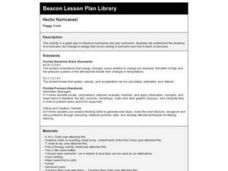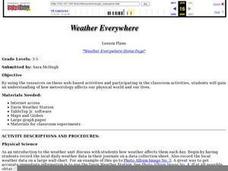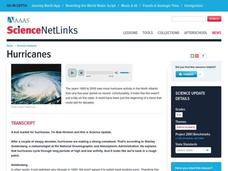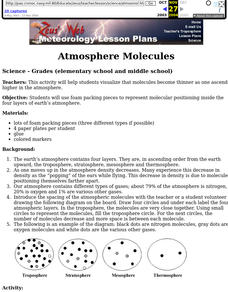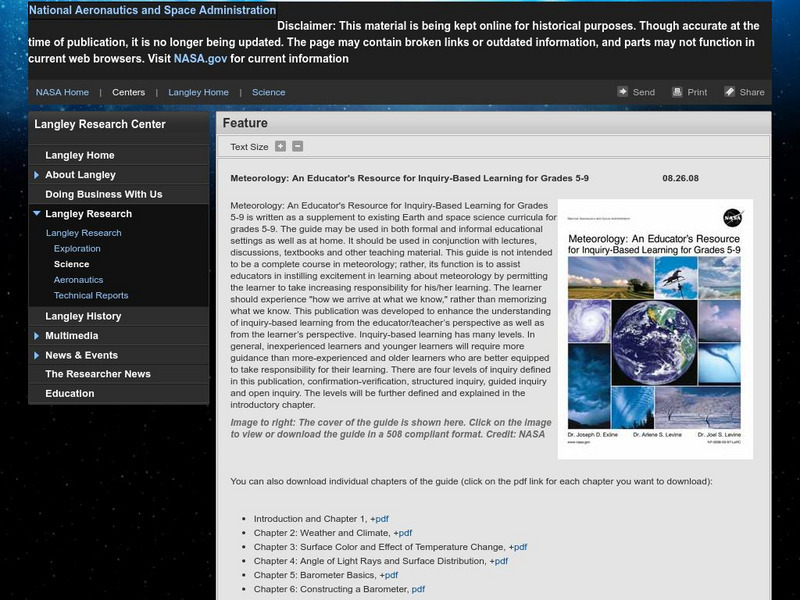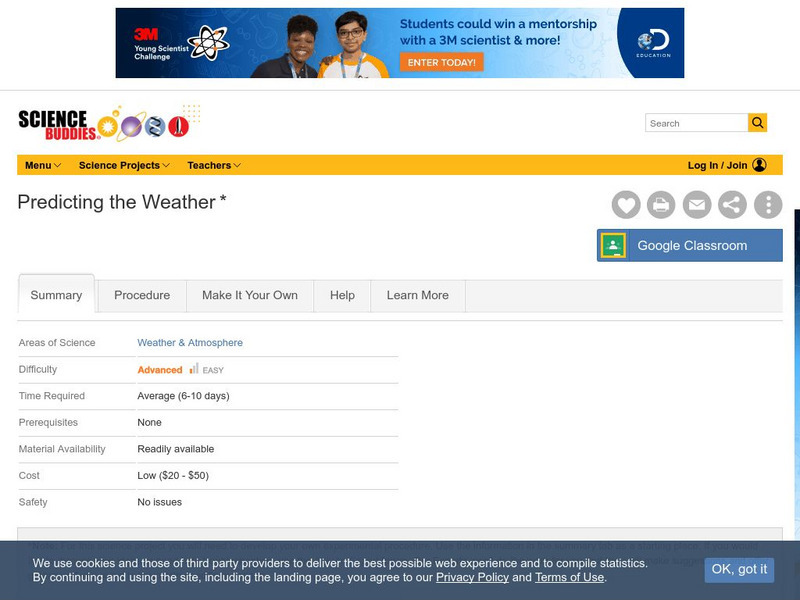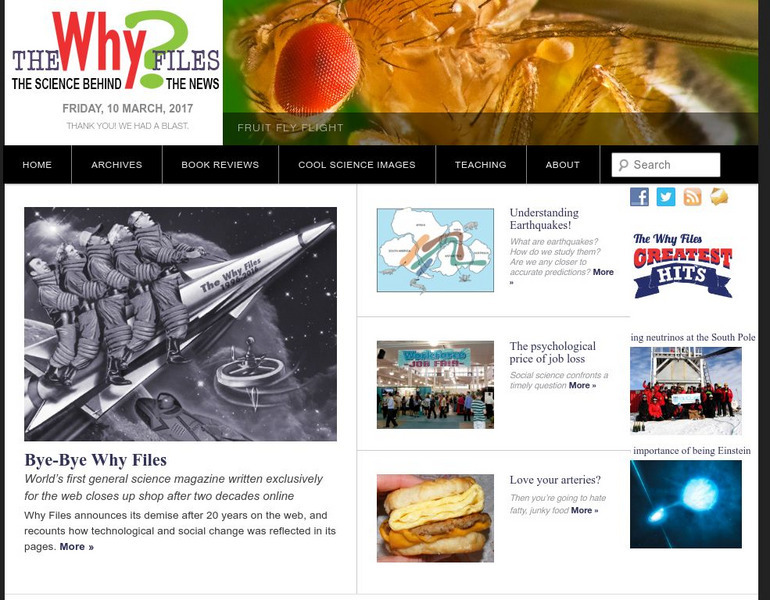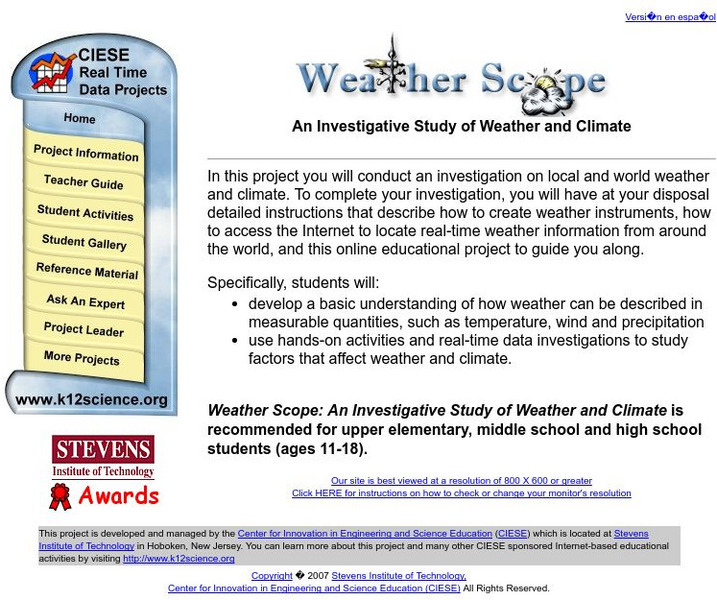Curated OER
Hectic Hurricanes!
Students determine what they know about hurricane formation. They experiment to explain hurricane formation and track a hurricane that forms in the Caribbean Islands.
Curated OER
Weather Everywhere
Students gain an understanding of how meteorology affects our physical world and our lives. They utilize resources on web-based activities and participate in the classroom activities to enrich their understanding.
Curated OER
What Causes Irregular Temperature Patterns?
Students examine common trends in climate across the U.S. They identify the anomalies in hot-cold temperature differences in the U.S and locate them on the map using latitude and longitude coordinates.
Curated OER
Investigation 7 - Interpreting Weather Data
Fourth graders interpret the weather data they gathered in Investigation 6. They take an average of each component in each season. They compare the same components of each season and write the differences they see between the seasons.
Curated OER
Investigation 6 - Collecting Weather Data
Fourth graders collect data for two weeks. They start seeing patterns and make predictions. They can predict what the weather be like the next day and for the next few days. They see if their predictions were correct from the previous day.
Curated OER
Hurricanes
Students listen to a transcript of an interview about an upswing in hurricanes with Stanley Goldenberg, a researcher with the National Oceanographic and Atmospheric Administration. students participate in a series of discussion questions.
Curated OER
Dateline: El Niño
Students explore El Nino and take the role of a reporter gathering the facts for a news story. Reports are presented orally, like a newscast, written or in whatever form the teacher prefers.
Curated OER
Cold Front Characteristics
Students study the weather conditions before, during, and after cold front passage. Two cold front examples are provided so that comparisons can be made. They are divided in two large groups. Each group studies a different cold front case.
Curated OER
Atmosphere Molecules
Young scholars use foam packing pieces to represent molecular positioning inside the four layers of earth's atmosphere. This lesson help students visualize that molecules become thinner as one ascends higher in the atmosphere.
Curated OER
Condensation
Students explain how water changes from vapor to liquid with a change in temperature by engaging in this experiment. They use a worksheet imbedded in this lesson to guide their inquiry.
NASA
Nasa: Meteorology
Educator's resource guide to be used as a supplement to existing curriculum and to enhance the understanding of inquiry-based learning from both the educator/teacher's perspective as well as from the learner's perspective. Individual...
Science Buddies
Science Buddies: Predicting the Weather
Here's a good way to get yourself on TV. This science fair project will help you learn how to predict the weather. So who knows, maybe you'll be more accurate than your local meteorologist.
Oklahoma Mesonet
University of Oklahoma: Overview of Meteorology
The University of Oklahoma explores numerous types of weather and atmospheric changes, as well as the reasons behind them. Content details the four seasons, common meteorological variables, the vertical structure of the atmosphere, how...
Other
University of Windsor: Climates on a Rotating Earth
This site offers the text of a college lecture on the atmosphere, with information on the effect prevailing westerlies have on North America.
Other
California Regional Weather Server: Jet Stream Analyses and Forecasts
California Regional Weather Service provides the latest jet stream analyses and forecasts for the Northern Hemisphere, Eastern Pacific & Western North America, North America, North Atlantic, and the Southern Hemisphere.
Other
Dalhousie University: Department of Oceanography
Find out more about Grad studies, classes, seminars in the area of oceanography and also see some amazing pictures.
DOGO Media
Dogo News: Week of 4 18 16: Measuring Raindrops From Space
Article reports on why measuring the size of raindrops from space may help improve weather predictions. Includes video.
Seeker
Seeker: Week of 10 28 13: Mystery Blob Reveals Man Made Phenomenon
Article reports on the mystery of a large mass that appeared on weather radar even though there was no storm in sight.
Other
Niwa: Climate and Weather
Want to learn more about the climate and weather? This webpage contains links to websites around the world concerned with providing information about climate and weather. Topics include ozone, greenhouse gases, global warming, tornadoes,...
TeachEngineering
Teach Engineering: Backyard Weather Station
In this hands-on activity, students use their senses to describe what the weather is doing and to predict what it might do next. After gaining a basic understanding of weather patterns, students will become state park engineers and build...
NASA
Sci Jinks: Learn Satellite Meteorology
A collection of learning modules is offered to enhance studying meteorology. This opportunity should peek students' interests as they work through geoscience, physics, chemistry, and applied sciences. Each module includes exercises and...
University of Wisconsin
The Why Files: Science Behind the News
The Why? Files from the University of Wisconsin explains the science behind the news. The website, tackling issues in news headlines, provides a good mix of information and interactivity that takes the "chore" out of learning.
Other
About Wmo World Meteorological Organization
The World Meteorological Organization (WMO) watches the weather and keeps up to date weather patterns. It is the coordinator of weather information for the world's scientific community.
Center for Innovation in Engineering and Science Education, Stevens Institute of Technology
Ciese Real Time Data Projects: Weather Scope: A Study of Weather and Climate
Use real-time data to study factors that affect weather and climate, create weather instruments, and share data with students around the world.


